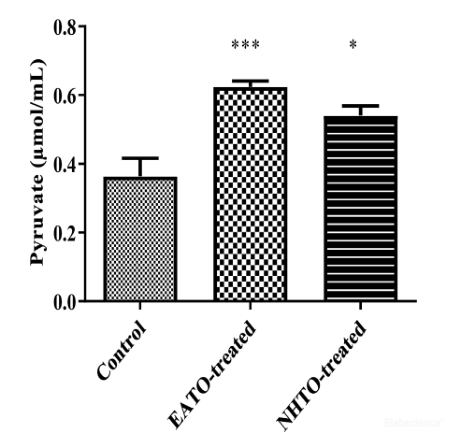Pyruvic Acid Colorimetric Assay Kit
SKU: E-BC-K130-S-100
To better serve you, we would like to discuss your specific requirement.
Please Contact Us for a quote.
Pyruvic Acid Colorimetric Assay Kit
| SKU # | E-BC-K130-S |
| Detection Instrument | Spectrophotometer (505 nm) |
| Detection Method | Colorimetric method |
Product Details
Properties
| Sample Type | Serum, plasma, tissue |
| Sensitivity | 0.006 μmol/mL |
| Detection Range | 0.006-2.0 μmol/mL |
| Detection Method | Colorimetric method |
| Assay type | Quantitative |
| Assay time | 60 min |
| Precision | Average inter-assay CV: 1.500% | Average intra-assay CV: 1.300% |
| Other instruments required | Micropipettor, Vortex mixer, Incubator |
| Other reagents required | Normal saline (0.9% NaCl), PBS (0.01 M, pH 7.4) |
| Storage | 2-8℃ |
| Valid period | 12 months |
Images
T M Salman et al investigate the pathways and mechanism of hypoglycemic effect with Telfairia occidentails. Pyruvic acid levels in rat plasma was determined using pyruvic acid colorimetric assay kit (E-BC-K130-S).

Both EATO and NHTO significantly increased the pyruvate concentration. (***P<0.001, *P<0.01 vs. Control)
Dilution of Sample
It is recommended to take 2~3 samples with expected large difference to do pre-experiment before formal experiment and dilute the sample according to the result of the pre-experiment and the detection range (0.006-2.0 μmol/mL).
The recommended dilution factor for different samples is as follows (for reference only):
| Sample type | Dilution factor |
| Human serum | 1 |
| Mouse serum | 1 |
| Mouse plasma | 1 |
| 10% Mouse liver tissue homogenate | 1 |
| 10% Rat kidney tissue homogenate | 1 |
| 10% Rat heart tissue homogenate | 1 |
Note: The diluent is normal saline (0.9% NaCl) or PBS (0.01 M, pH 7.4).
Detection Principle
Pyruvic acid can react with chromogenic agent and the reaction product is reddish brown in alkaline solution. The depth of color is directly proportional to the pyruvate content. The pyruvate content can be calculated by measuring the OD value at 505 nm.

Kit Components & Storage
| Item | Component |
Size 1 (50 assays) |
Size 2 (100 assays) |
Storage |
| Reagent 1 | Clarificant | 0.6 mL ×1 vial | 1.2 mL ×1 vial | 2-8°C, 12 months |
| Reagent 2 | Chromogenic Agent | 3 mL ×1 vial | 6 mL ×1 vial | 2-8°C, 12 months, shading light |
| Reagent 3 | Alkali Reagent | 10 mL ×1 vial | 20 mL ×1 vial | 2-8°C, 12 months |
| Reagent 4 | 2 μmol/mL Sodium Pyruvate Standard | 1.6 mL ×1 vial | 1.6 mL ×1 vial | 2-8°C, 12 months |
Note: The reagents must be stored strictly according to the preservation conditions in the above table. The reagents in different kits cannot be mixed with each other. For a small volume of reagents, please centrifuge before use, so as not to obtain sufficient amount of reagents.
Technical Data:
Parameter:
Intra-assay Precision
Three human serum samples were assayed in replicates of 20 to determine precision
within an assay. (CV = Coefficient of Variation)q
| Parameters | Sample 1 | Sample 2 | Sample 3 |
| Mean (μmol/mL) | 0.55 | 1.05 | 1.36 |
| %CV | 2.6 | 1.2 | 1.2 |
Inter-assay Precision
Three human serum samples were assayed 20 times in duplicate by three operators
to determine precision between assays.
| Parameters | Sample 1 | Sample 2 | Sample 3 |
| Mean (μmol/mL) | 0.55 | 1.05 | 1.36 |
| %CV | 1.4 | 1.6 | 1.5 |
Recovery
Take three samples of high concentration, middle concentration and low concentration to test the samples of each concentration for 6 times parallelly to get the average recovery rate of 100%.
| Standard 1 | Standard 2 | Standard 3 | |
| Expected Conc. (μmol/mL) | 0.7 | 1.3 | 1.7 |
| Observed Conc. (μmol/mL) | 0.7 | 01.3 | 1.8 |
| Recovery rate (%) | 99 | 98 | 103 |
Sensitivity
The analytical sensitivity of the assay is 0.006 μmol/mL. This was determined by adding two standard deviations to the mean O.D. obtained when the zero standard was assayed 20 times, and calculating the corresponding concentration.
Standard Curve:
As the OD value of the standard curve may vary according to the conditions of the actual assay performance (e.g. operator, pipetting technique or temperature effects), so the standard curve and data are provided as below for reference only
| Concentration (μmol/L) | 0 | 0.1 | 0.2 | 0.5 | 1 | 1.5 | 2 |
| Average OD | 0.017 | 0.048 | 0.094 | 0.203 | 0.387 | 0.562 | 0.762 |
| Absoluted OD | 0 | 0.032 | 0.078 | 0.187 | 0.370 | 0.546 | 0.745 |



